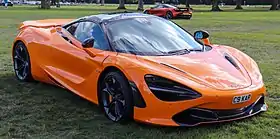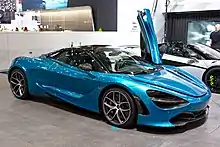McLaren 720S
The McLaren 720S is a sports car designed and manufactured by British automobile manufacturer McLaren Automotive. It is the second all-new car in the McLaren Super Series, replacing the 650S beginning in May 2017.
| McLaren 720S | |
|---|---|
 | |
| Overview | |
| Manufacturer | McLaren Automotive |
| Production | 2017–present |
| Assembly | Woking, Surrey, England |
| Designer | Robert Melville[1][2] |
| Body and chassis | |
| Class | Sports car (S) |
| Body style |
|
| Layout | Rear mid-engine, rear-wheel drive |
| Platform | MonoCage II carbon fibre monocoque |
| Doors | Butterfly |
| Related | |
| Powertrain | |
| Engine | 4.0 L M840T twin-turbocharged V8 |
| Power output | 720 PS (530 kW; 710 hp) 765 PS (563 kW; 755 hp) (765LT) |
| Transmission | 7-speed dual-clutch |
| Dimensions | |
| Wheelbase | 2,670 mm (105.1 in)[3] |
| Length | 4,544 mm (178.9 in)[3] 4,600 mm (180 in) (765LT) |
| Width | 1,930 mm (76.0 in)[3][4] |
| Height | 1,196 mm (47.1 in)[3] 1,159 mm (45.6 in) (765LT) |
| Kerb weight | 1,437 kg (3,167 lb) (720S Coupé)[5] 1,516 kg (3,343 lb) (720S Spider)[6] 1,339 kg (2,952 lb) (765LT) |
| Chronology | |
| Predecessor | McLaren 650S |
The 720S was launched at the Geneva Motor Show on 7 March 2017 and is built on a modified carbon monocoque, which is lighter and stiffer in contrast to the 650S.
Specifications
The 720S is the first all-new car to be introduced by McLaren as a part of its new plan to launch 15 new cars into the market by 2022. The 720S according to McLaren is 91% new as compared to its predecessor.
Engine
The 720S features McLaren's new M840T engine which is an evolution of the M838T used in the 650S.[7] It is a 3,994 cc (4.0 L; 243.7 cu in) twin-turbocharged V8 engine. However, the stroke has been lengthened by 3.6 mm to increase the capacity and 41% of the engine's components are new. The engine uses new twin-scroll turbochargers which have a low inertia titanium-aluminium turbines which spin with maximum efficiency with the help of actively controlled waste gates.[8][9] The engine has a rated power output of 720 PS (530 kW; 710 hp) at 7,000 rpm, giving the car its name; the maximum torque is 568 lb⋅ft (770 N⋅m) at 5,500 rpm.[10]
Suspension
The ProActive Chassis Control II active suspension system used in the 720S is an evolution of the system used in the 650S but is 16 kg (35 lb) lighter than the previous version. The new system features accelerometers on the top and pressure sensors at the bottom of the dampers to precisely communicate to the car's onboard computer the driving conditions in real-time for optimum suspension settings. The system uses findings from a PhD course at the University of Cambridge.[7][8]
Chassis

The carbon fibre tub used in the 720S' chassis is based on the similar principle of the MonoCage unit in the P1 but is 18 kg (40 lb) lighter than its predecessor. Called the MonoCage II, the tub allows for dihedral doors with large cutouts for easier entry and exit. It also reduces the size of the pillars of the roof, improving visibility for the driver. The same tub underpins the Senna, Speedtail and the Elva sports cars.[8]
Interior
The interior is designed to be a blend of modern and race-inspired elements. Alcantara and Weir leather upholstery along with carbon fibre trim is standard. A Bowers and Wilkins audio system is also standard equipment. Fixed carbon fibre racing seats are included as an option. The main focus of the interior is the driver and this is reflected by the new digital display behind the steering wheel which retracts to a thin screen to reveal vital information to the driver when the car is in track mode. The touch screen on the centre console is angled away from the driver but vital controls are designed to be in the driver's easy reach. The car comes with two driving modes, default and comfort with the former focusing on an enhanced track driving experience.[8]
Performance
According to McLaren the 720S can accelerate to 100 km/h (62 mph) in 2.9 seconds, to 200 km/h (124 mph) in 7.8 seconds, can achieve a maximum speed of 341 km/h (212 mph),[10] and has a 1⁄4 mile (402 m) time of 10.3 seconds.[11] The 720S also comes with Variable Drift Mode, which manipulates the stability control to help drift the car.[12]
Efficiency
McLaren claims class-leading efficiency for the new 720S, with CO2 emissions of 249 g/km and combined fuel economy of 26.4 mpg‑imp (22.0 mpg‑US; 10.7 L/100 km)[13]—both of these figures represent an improvement of around 10% from the 650S.
Design


The McLaren 720S features twin-hinged dihedral doors and many design features from the McLaren F1. The headlights hide air vents that funnel incoming air to two small radiators in front of the wheels. The doors feature air channels that direct air to the engine. The rear of the car features thin LED taillights similar to those on the McLaren P1, and two round exhaust pipes. The design was inspired by the great white shark and features a teardrop-shaped cockpit.[7] All of the exterior features result in an improvement of 50% more downforce than the 650S.[14] The interior of the car includes a folding driver display and carbon fibre accents.[15]
Variants
720S Velocity
McLaren Special Operations unveiled the McLaren 720S Velocity just one day after the 720S was revealed. It featured Nerello Red and Volcano Red paint scheme, and a carbon fibre bonnet. In addition to those, the wheels are lightweight aluminium painted metallic bronze. The interior has Carbon Black Alcantara trim with red highlights and carbon fibre accents.[16][17]
720S GT3
.jpg.webp)
Unveiled at the 2018 Pebble Beach Concours d'Elegance, the 720S GT3 marks the beginning of McLaren's outreach to both amateur and professional racing drivers. The car is claimed to have been changed by 90% when compared to the road-legal version. The main highlights include the M840T twin-turbocharged V8 engine tuned to race specifications; mated to a 6-speed sequential manual transmission instead of the dual-clutch unit found on the road car, a newly developed roll cage, a fixed carbon-kevlar racing seat, a six-point racing harness, a roof-hatch extraction system, along with side-impact foam, all complying to the latest FIA GT3 regulations. The exterior is extensively modified as well and now includes a large fixed rear wing, bigger ram air-intake at the front, different headlight clusters and a large rear diffuser. All of the aerodynamic elements have been thoroughly tested and calibrated for maximum efficiency by using Computational Fluid Dynamics (CFD) which saves the research and development costs of making a full-scale mock-up and testing it.
McLaren's main aim with the 720S GT3 was to allow easy access of the car to drivers and teams, not just on driving standpoint, but on serviceability and financial viability as well. Keeping that into consideration, efforts have been made to keep the car as fuel-efficient as possible while working with the tyre supplier, Pirelli to allow the car to be able to last endurance races with ease.
The 720S GT3 would be available for the general public and racing teams at the start of the 2019 season of the FIA GT3 Championship.[18]
720S Spider

.jpg.webp)
The 720S Spider was introduced in December 2018 as the brand's new open-top flagship sports car. Due to the integral roll structure of the monocoque used in the 720S, the Spider did not need additional bracing to compensate for the loss of a fixed roof. The modified monocoque loses the spine running from front to the rear of the car and is dubbed the Monocage II-S. Due to the loss of the roof, the 720S Spider uses traditional dihedral doors. The Spider weighs 45 kg (100 lb) more than its coupé counterpart due to the retractable hardtop system. The Spider marks the debut of new 10-spoke alloy wheels and new exterior colour options.
The roof is a single piece of carbon fibre and takes 11 seconds for operation, 6 seconds quicker than the 650S Spider. The roof can be operated at speeds up to 50 km/h (31 mph). The Spider uses the "flying buttress" as used on all convertible McLaren models. There is an added window on the buttress of the car to increase rear visibility. The retractable window between the roll-over hoops is carried over from the 650S Spider.
The engine and the transmission remain the same as the coupé with the engine generating the same amount of power. The Spider can accelerate to 97 km/h (60 mph) from a standstill in 2.9 seconds, to 193 km/h (120 mph) in 7.9 seconds and on to a top speed of 341 km/h (212 mph) with the top closed. The top speed reduces by 16 km/h (10 mph) with the top retracted.[19][20]
765LT

Unveiled on 3 March 2020, the 765LT is a track-focused version of the 720S and the successor to the 675LT as a Super Series Longtail car. The M840T engine is now rated at 765 PS (563 kW; 755 hp) at 7,500 rpm and 590 lb⋅ft (800 N⋅m) of torque at 5,500 rpm achieved with a higher-capacity fuel pump, forged aluminium pistons and a three-layer head gasket from the Senna. The top speed is lowered from the 720S's 341 km/h (212 mph) to 330 km/h (205 mph) due to added drag created by the added high downforce parts, although the 765LT weighs 80 kg (176 lb) less than the 720S at 1,339 kg (2,952 lb) in its lightest configuration and has a quicker 0-100 km/h (0-62 mph) time of 2.8 seconds. It also can hit 0-200 km/h (0-124 mph) in 7.0 seconds and complete a quarter-mile dash in 9.9 seconds according to McLaren.[21]
The Senna's brake callipers are also available as an extra-cost option; McLaren claims these have four times the thermal conductivity as conventional carbon ceramics, while Pirelli Trofeo R tyres are standard. Suspension changes involve a 5 mm (0.2 in) reduction in ride height and the use of lightweight main springs with secondary "helper" units as well as an upgraded Proactive Chassis Control system. The aerodynamics are redesigned to produce 25% more downforce than the 720S, featuring front fender vents, a larger front splitter and a longer active wing element at the rear at the cost of less noise insulation, thinner-gauge glass and stiffened engine mounts. The rear of the car also features a quad-exit full titanium exhaust to distinguish it from the 720S. Production will be limited to 765 cars globally with customer deliveries in October 2020.[22][23][24]
Awards
Mclaren 720s named 2019 World Performance Car by World Car Awards in conjunction with the New York International Auto Show.[25]
References
- "McLaren 720S - Super Series". Cars.mclaren.com. Retrieved 2017-03-11.
- Press Kits: McLaren 720S
- "McLaren 720S revealed: full information and unpublished images of the dawn of a new era for McLaren's Super Series". cars.mclaren.press. Retrieved 13 May 2018.
- "McLaren 720S 4.0 V8 (720 Hp) SSG Technical Data from auto-data.net".
- "2018 McLaren 720S First Test: The New Normal is Nuts". motortrend.com. Motor Trend. Retrieved 7 December 2018.
- "McLaren's 2019 720S Spider - A Convertible Without Compromise". caranddriver.com. Car and Driver. Retrieved 11 August 2019.
- "McLaren 720S - Super Series". cars.mclaren.com. Retrieved 2017-03-23.
- MacKenzie, Agnus (2017-05-03). "2018 McLaren 720S First Drive: Teacher's Pet". Motor Trend. Retrieved 2019-04-28.
- "212mph McLaren 720S officially revealed at Geneva Motor Show". Autocar. 2017-08-03. Retrieved 2017-03-08.
- "McLaren Super Series - 720S - Specification". cars.mclaren.com. Retrieved 2017-03-23.
- Andrew English. "McLaren 720S: First look at the new hot-blooded Englishman". Autoblog. Retrieved 2017-03-23.
- Baisden, Michael (2017-03-01). "McLaren 720S: Revamping to Raise the Bar For Supercars". Art of Gears. Retrieved 2017-03-23.
- Tingwall, Eric (April 2018). "2018 McLaren 720S". Retrieved 2018-04-05.
- "2018 McLaren 720S First Look: Recalibrating the Supercar - Motor Trend". Motor Trend. 2017-03-07. Retrieved 2017-03-23.
- "2018 McLaren 720S". Top Speed. Retrieved 2017-03-23.
- "MSOooh, Ahhh: McLaren Wastes No Time with Custom 720S Velocity". Retrieved 2017-03-23.
- "Bespoke McLaren 720lt Velocity by MSO revealed | Autocar Magazine". Autocar Magazine. 2017-03-08. Retrieved 2017-11-10.
- Silvestero, Brian (2018-08-24). "The Stunning McLaren 720S GT3 Is Here to Dominate Race Tracks Around the World". Road and Track Magazine. Retrieved 2018-08-25.
- Brownell, Bradley (9 December 2018). "The 2019 McLaren 720S Spider Is A True 200 mph Open Top". Jalopnik. Retrieved 10 December 2018.
- Pattni, Vijay (9 December 2018). "The new McLaren 720S Spider is a 202mph convertible". Top Gear. Retrieved 10 December 2018.
- https://cars.mclaren.com/en/super-series/765lt/specification
- MacKenzie, Angus (3 March 2020). "2020 McLaren 765LT First Look: Fifth Longtail Model Is 720S-Based". Motor Trend. Retrieved 3 March 2020.
- "2021 McLaren 765LT: What We Know So Far". Car and Driver. Retrieved 5 July 2020.
- Vijayenthiran, Viknesh (7 April 2020). "McLaren 765LT supercar bows with 755 horsepower, $358,000 price tag". Motor Authority. Retrieved 5 July 2020.
- "2019 World Car Awards - And Now There Is One - McLaren 720S - 2019 World Performance Car". PR News Wire. Apr 17, 2019.